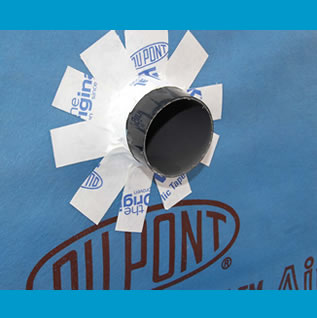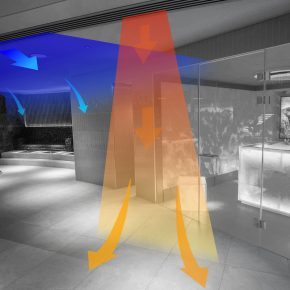
Airtightness installation advice from DuPont Tyvek
Over the course of a normal winter’s day up to 0.7kg of water vapour can pass through a 1mm gap over 100mm building component thickness, across 1m length at 10Pa pressure difference. Following are some best practice guidelines for successful installations, as experienced by the DuPont Tyvek® Technical team and developed through both on-site support and direct feedback from contractors.
Continuous sealing
To achieve a satisfactory level of airtightness, AVCLs must be sealed at all laps, junctions and penetrations. To reduce the risk of inadequate sealing, it is recommended to keep penetrations to a minimum and consider a services void for electrical fittings, e.g. sockets, light fittings, etc. A services void can be created by spacing off the internal lining (plasterboard) from the AVCL. Timber battens, minimum 25mm may be used for this.
Not all penetrations in the envelope are avoidable.
For penetrations such as windows, doors or pipework that cannot be addressed with a services void, careful attention must be paid to sealing. Those penetrations can be sealed with standard acrylic tape or flexible tape (which offers faster, safer and more adaptable installation.) To ensure a tight bond, it is crucial to press the tape firmly onto the membrane and to the item being sealed.
Fixing the membrane timber, concrete and steelwork
For timber structures, initial/temporary fixing of the membrane is normally achieved with stainless steel staples. These may be positioned at the overlap where the AVCL is to be later sealed with tape. For best practice, fix the membrane using double sided tape, as this will help to minimise penetrations. Where shrinkage or movement within the structure is likely, a flexible seal, such as butyl tape, will be of benefit.
When the AVCL is fixed to a concrete substrate, ensure the surface is clean and dry. A double sided acrylic tape will provide an effective bond between the two materials if the concrete surface is relatively smooth. Where the surface is uneven a butyl tape is recommended, as it can accommodate small gaps and imperfections.
Double sided acrylic tape is also recommended to temporarily fix an AVCL to steelwork. A permanent fix will occur when timber battens, metal channels/brackets or the internal linings are installed over. Care should be taken to ensure that the time period allowed between these applications is minimal. For extra security a drill tip screw or self tapping screw with an EPDM washer may also be used.
Repair all damage
Any accidental rips, tears or perforations made in the membrane should be immediately made good to avoid air leakage after installation. The damaged area may be repaired with tape, but extensive damage should be covered with an extra piece of membrane laid over the damage and sealed with tape. The new patch’ should extend at least 100mm around the damage in all directions.
Down lights and Ceiling hatches require special attention.
Before fitting the ceiling hatch, neatly trim the AVCL to the hatch opening, fold the flaps inward and carefully seal for airtightness especially the corners. When the hatch is secured into place a butyl tape fixed between the hatch frame and AVCL will help to maintain airtightness where the fixing screws are driven through.
Light fittings often necessitate cutting holes in the AVCL for wiring, which would then need to be sealed for airtightness. Complicated sealing work can be avoided by creating a services void with battens which will accommodate the wiring and space the lining off the membrane.
Select the right sealing tape
Not all tapes are the same. Before getting started make sure that the tape being used is compatible with the membrane in every case, if there’s any doubt. To simplify things, DuPont have developed a range of tapes to use specifically with their AirGuard® AVCL membranes – working together as a system.
DuPont Building Innovations offers a range of AVCL products covering a broad range of applications:
DuPont AirGuard® Control, 25 MNs/g, which is suitable for roof, wall and floor installations with a diffusion open outer layer. This is a mechanically strong membrane with minimal risk of damage during installation, it is also translucent making it ideal for air-blown insulation applications, allowing the structure to be easily located for fixing.
DuPont AirGuard® Reflective, 10000 MNs/g: This AVCL is 100% air and vapour tight. It has a metallised surface with very low emissivity which significantly improves its thermal insulation performance, providing an additional 0.67 m2K/W to the R-value. It is ideal for applications with high humidity that require a membrane of high vapour resistance.
DuPont AirGuard® Smart is an exceptional membrane with highly adaptable vapour resistance. It helps to protect against structural mould damage due to its high levels of drying out potential. Furthermore its flexibility combined with excellent robustness, makes it easy to install and handle.
The selection of an AVCL depends on a number of criteria, for example; room humidity level, the external sd-value, or the vapour permeability of the insulation. DuPont has developed a product selector to help choose from its range of AVCL products. The technical hotline team is also available to assist with further information on application specific questions.
DuPont Protection Solutions
BBSP1
Bristol & Bath Science Park
Dirac Crescent
Emersons Green
Bristol
BS16 7FR
Phone: 08444 068 722
Technical enquiries: Tyvek.construction@dupont.com
Visit Supplier's page
Latest news

1st April 2025
Gilberts Takes Thermal Comfort to New Heights
Gilberts Blackpool is continuing to build on its reputation as a pioneer with the unveiling of ThermaAstute™ – the most extensive range of thermally sensitive diffusers in the market.
Posted in Air Conditioning, Articles, Building Industry News, Building Products & Structures, Building Services, Facility Management & Building Services, Heating, Ventilation and Air Conditioning - HVAC, Innovations & New Products, Restoration & Refurbishment, Retrofit & Renovation, Sustainability & Energy Efficiency
1st April 2025
University of Bath Student Helps Vent-Axia Win Two Environmental Industry Awards
Leading ventilation manufacturer, Vent-Axia, is delighted that the valuable work University of Bath student Roben Els undertook during an industry placement at the company contributed to it winning two environmental industry awards.
Posted in Air Conditioning, Articles, Awards, Building Industry Events, Building Industry News, Building Products & Structures, Building Services, Heating, Ventilation and Air Conditioning - HVAC, Recruitment, Retrofit & Renovation, Sustainability & Energy Efficiency, Training
1st April 2025
Ahmarra: Fire Doors Designed for Hospitals & Healthcare Environments
Ahmarra is a leading UK specialist in fire doors for healthcare environments, having manufactured and installed thousands of bespoke doorsets for NHS hospitals across London and the South East.
Posted in Access Control & Door Entry Systems, Accessibility, Acoustics, Noise & Vibration Control, Architectural Ironmongery, Articles, Building Industry News, Building Products & Structures, Building Services, Building Systems, Doors, Facility Management & Building Services, Health & Safety, Interior Design & Construction, Interiors, Restoration & Refurbishment, Retrofit & Renovation, Security and Fire Protection, Timber Buildings and Timber Products, Wooden products
1st April 2025
Mitsubishi Electric: New intuitive, IoT-ready centralised controller offers instant access to 400 units
Mitsubishi Electric has launched a new user-friendly, touchscreen controller to offer full remote controllability, monitoring and reporting for up to 400 air conditioning units.
Posted in Air Conditioning, Articles, Building Industry News, Building Products & Structures, Building Services, Facility Management & Building Services, Heating Systems, Controls and Management, Heating, Ventilation and Air Conditioning - HVAC, Information Technology, Innovations & New Products, Pipes & Fittings, Plumbing, Posts, Research & Materials Testing, Retrofit & Renovation, Sustainability & Energy Efficiency
 Sign up:
Sign up: